GMDSS那些事儿
- 格式:doc
- 大小:1.70 MB
- 文档页数:29
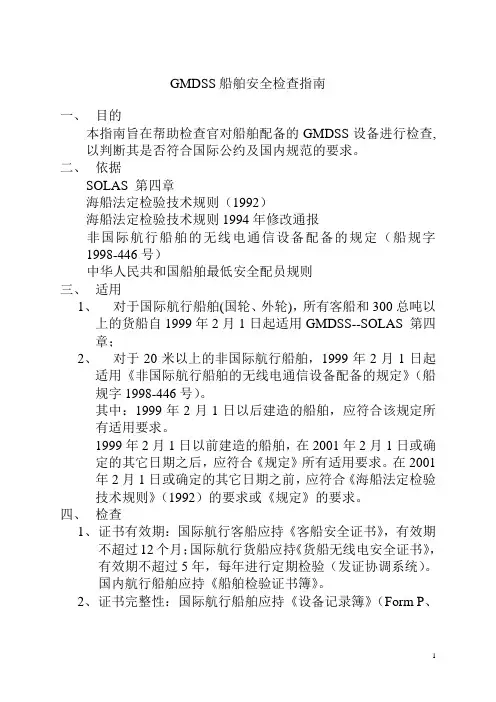
GMDSS船舶安全检查指南一、目的本指南旨在帮助检查官对船舶配备的GMDSS设备进行检查,以判断其是否符合国际公约及国内规范的要求。
二、依据SOLAS 第四章海船法定检验技术规则(1992)海船法定检验技术规则1994年修改通报非国际航行船舶的无线电通信设备配备的规定(船规字1998-446号)中华人民共和国船舶最低安全配员规则三、适用1、对于国际航行船舶(国轮、外轮),所有客船和300总吨以上的货船自1999年2月1日起适用GMDSS--SOLAS 第四章;2、对于20米以上的非国际航行船舶,1999年2月1日起适用《非国际航行船舶的无线电通信设备配备的规定》(船规字1998-446号)。
其中:1999年2月1日以后建造的船舶,应符合该规定所有适用要求。
1999年2月1日以前建造的船舶,在2001年2月1日或确定的其它日期之后,应符合《规定》所有适用要求。
在2001年2月1日或确定的其它日期之前,应符合《海船法定检验技术规则》(1992)的要求或《规定》的要求。
四、检查1、证书有效期:国际航行客船应持《客船安全证书》,有效期不超过12个月;国际航行货船应持《货船无线电安全证书》,有效期不超过5年,每年进行定期检验(发证协调系统)。
国内航行船舶应持《船舶检验证书簿》。
2、证书完整性:国际航行船舶应持《设备记录簿》(Form P、Form R)。
3、海区划定:中国A1海区是以沿海13个VHF DSC岸台为圆心,以25海里为半径的圆所覆盖的海域。
A2海区是以沿海16个MF DSC岸台为圆心,以100海里为半径的圆所覆盖的海域(基本上对我国距岸100海里以内的沿海海域形成链状覆盖)。
通常中、日、韩航线、中国南北航线属于A1+A2海区。
A3海区是除A1、A2海区外,INMARSAT静止轨道卫星覆盖区域。
A1+A2+A3通常指南北纬70度之间区域,航行欧洲、美洲、澳洲、非洲均属于该海区。
A4海区是南北纬70度到两极区域,南极考察船航行的区域属于该海区。
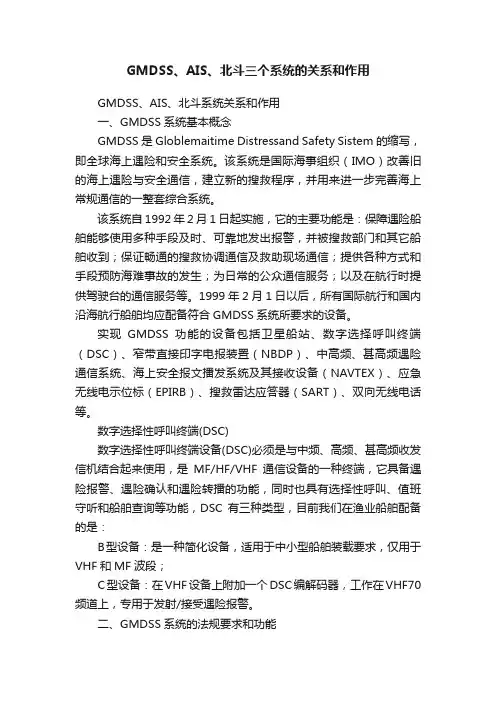
GMDSS、AIS、北斗三个系统的关系和作用GMDSS、AIS、北斗系统关系和作用一、GMDSS系统基本概念GMDSS是Globlemaitime Distressand Safety Sistem的缩写,即全球海上遇险和安全系统。
该系统是国际海事组织(IMO)改善旧的海上遇险与安全通信,建立新的搜救程序,并用来进一步完善海上常规通信的一整套综合系统。
该系统自1992年2月1日起实施,它的主要功能是:保障遇险船舶能够使用多种手段及时、可靠地发出报警,并被搜救部门和其它船舶收到;保证畅通的搜救协调通信及救助现场通信;提供各种方式和手段预防海难事故的发生;为日常的公众通信服务;以及在航行时提供驾驶台的通信服务等。
1999年2月1日以后,所有国际航行和国内沿海航行船舶均应配备符合GMDSS系统所要求的设备。
实现GMDSS功能的设备包括卫星船站、数字选择呼叫终端(DSC)、窄带直接印字电报装置(NBDP)、中高频、甚高频遇险通信系统、海上安全报文播发系统及其接收设备(NAVTEX)、应急无线电示位标(EPIRB)、搜救雷达应答器(SART)、双向无线电话等。
数字选择性呼叫终端(DSC)数字选择性呼叫终端设备(DSC)必须是与中频、高频、甚高频收发信机结合起来使用,是MF/HF/VHF通信设备的一种终端,它具备遇险报警、遇险确认和遇险转播的功能,同时也具有选择性呼叫、值班守听和船舶查询等功能,DSC 有三种类型,目前我们在渔业船舶配备的是:B型设备:是一种简化设备,适用于中小型船舶装载要求,仅用于VHF和MF波段;C型设备:在VHF设备上附加一个DSC编解码器,工作在VHF70频道上,专用于发射/接受遇险报警。
二、GMDSS系统的法规要求和功能(一)GMDSS系统的法规要求我国根据《1977年国际渔船安全公约》的《1993年协议书》规定:对等于、大于和小于45米在A1、A2、A3、A4不同航区航行的船舶,安全通信设备的配备均有不同要求。
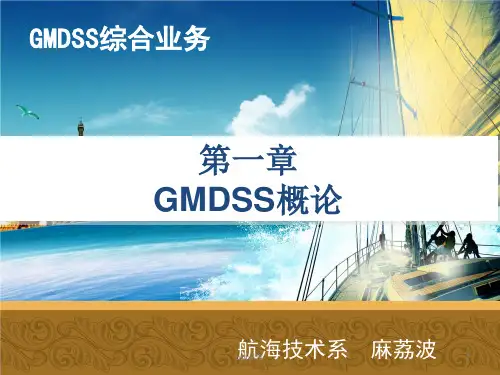
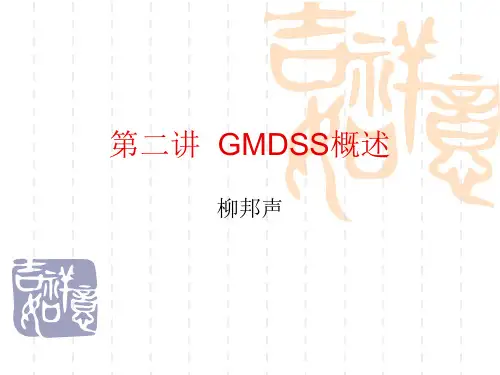
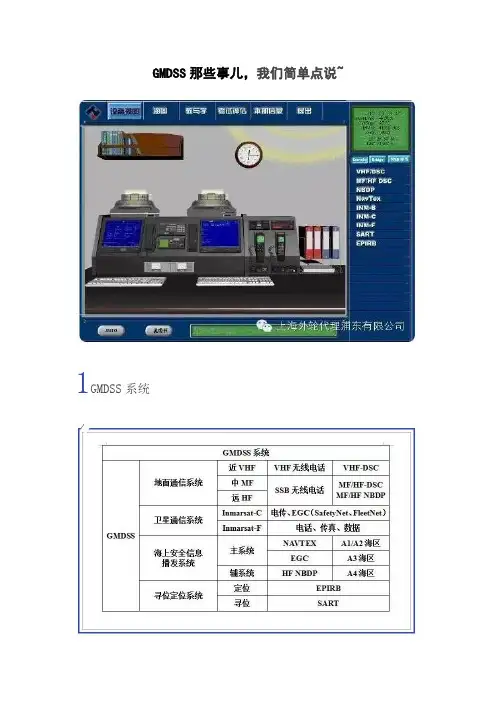
GMDSS那些事儿,我们简单点说~ 1GMDSS系统2GMDSS设备配备设备3四个海区报警手段的选择4GMDSS无线电人员证书种类及适用范围5各海区无线电人员配备要求6地面通信系统遇险安全呼叫频率和通信频率7NBDP工作模式8速率、时间、种类及空传号9NBDP&DSC10Inmarsat卫星的洋区编码11北京地面站接续码12各系统网络协调站13INMARSAT系统工作频率14INMARSAT业务代码INMARSAT业务代码国际海事卫星组织开发的特别业务都有专门的业务代码,业务代码由两位数字组成,由岸站提供,供船站选择使用。
常用两位码有:00-自动拨号31–海事查询32-医疗指导33-技术援助37–计时计费38-医疗援助39–海事援助42-航行警告43-船位报告92-启用试验00、11、13二位码业务一般是地面站必开放业务,其他特别业务的开放情况因地面站而异。
北京地面站除了开放00、11、13业务外,还开放33、92二位码业务。
15Inmarsat船站的识别码Inmarsat船站的识别码IMN(9位)➢ Inmarsat-F船站识别码:电话业务识别码76XXXXXXX;56/64 Kbit/s传输业务识别码60XXXXXXX➢∙1MIDXXXXX-Inmarsat–A标准业务➢∙3MIDXXXXX-Inmarsat-B标准业务➢∙4MIDXXXXX-Inmarsat-C标准业务➢∙6MIDXXXXX-Inmarsat-M标准业务注:MID为国家识别码16卫星船站通信号码构成➢Inmarsat-C船站(1)电传:船-船58* + 4MIDXXXXX船-岸 085 + 陆地电传号(2)传真:船-岸 86 + 区号(去“0”)+ 陆地传真号➢∙Inmarsat-F船站(1)电话:船-船 00 + 87* + 76XXXXXXX或 00 + 870 + 76XXXXXXX船-岸固定电话:00 + 86 + 区号(去“0”)+ 陆地电话号移动电话:00+86+手机号(2)传真:船-船 00 + 87* + 76XXXXXXX或 00 + 870 + 76XXXXXXX船-岸固定电话:00 + 86 + 区号(去“0”)+ 陆地传真号注:“*”代表1、2、3、4,分别是AOR-E、POR、IOR、AOR-W四个洋区,在未知船舶所在洋区时用870;00为自动业务代码17C&F系统比较18FBB&F7719海上安全信息播发系统20通信优先等级DSC有5个,分别是遇险呼叫、紧急呼叫、安全呼叫、船舶业务呼叫、常规呼叫INMARSAT有4个,分别是常规通信0、安全通信1、紧急通信2、遇险通信3NAVTEX有3个,分别是VITAL、IMPORTANT、ROUTINE21极化方式VHF 采用垂直极化波方式;INMARSAT采用右旋圆极化方式;EPIRB采用右旋圆极化方式;SART采用水平极化方式;EGC接收机采用右旋圆极化方式。
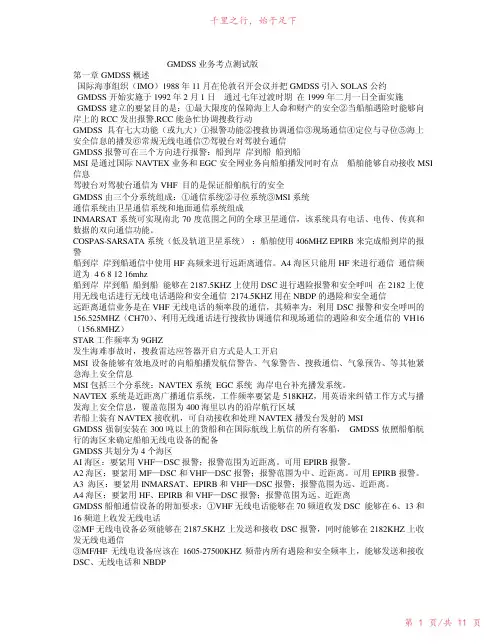
GMDSS业务考点测试版第一章GMDSS概述国际海事组织(IMO)1988年11月在伦敦召开会议并把GMDSS引入SOLAS公约GMDSS开始实施于1992年2月1日通过七年过渡时期在1999年二月一日全面实施GMDSS建立的要紧目的是:①最大限度的保障海上人命和财产的安全②当船舶遇险时能够向岸上的RCC发出报警,RCC能急忙协调搜救行动GMDSS具有七大功能(或九大)①报警功能②搜救协调通信③现场通信④定位与寻位⑤海上安全信息的播发⑥常规无线电通信⑦驾驶台对驾驶台通信GMDSS报警可在三个方向进行报警:船到岸岸到船船到船MSI是通过国际NA VTEX业务和EGC安全网业务向船舶播发同时有点船舶能够自动接收MSI 信息驾驶台对驾驶台通信为VHF 目的是保证船舶航行的安全GMDSS由三个分系统组成:①通信系统②寻位系统③MSI系统通信系统由卫星通信系统和地面通信系统组成INMARSAT系统可实现南北70度范围之间的全球卫星通信,该系统具有电话、电传、传真和数据的双向通信功能。
COSPAS-SARSATA系统(低及轨道卫星系统):船舶使用406MHZ EPIRB来完成船到岸的报警船到岸岸到船通信中使用HF高频来进行远距离通信。
A4海区只能用HF来进行通信通信频道为 4 6 8 12 16mhz船到岸岸到船船到船能够在2187.5KHZ上使用DSC进行遇险报警和安全呼叫在2182上使用无线电话进行无线电话遇险和安全通信2174.5KHZ用在NBDP的遇险和安全通信远距离通信业务是在VHF无线电话的频率段的通信,其频率为:利用DSC报警和安全呼叫的156.525MHZ(CH70)、利用无线通话进行搜救协调通信和现场通信的遇险和安全通信的VH16(156.8MHZ)STAR工作频率为9GHZ发生海难事故时,搜救雷达应答器开启方式是人工开启MSI设备能够有效地及时的向船舶播发航信警告、气象警告、搜救通信、气象预告、等其他紧急海上安全信息MSI包括三个分系统:NA VTEX系统EGC系统海岸电台补充播发系统。
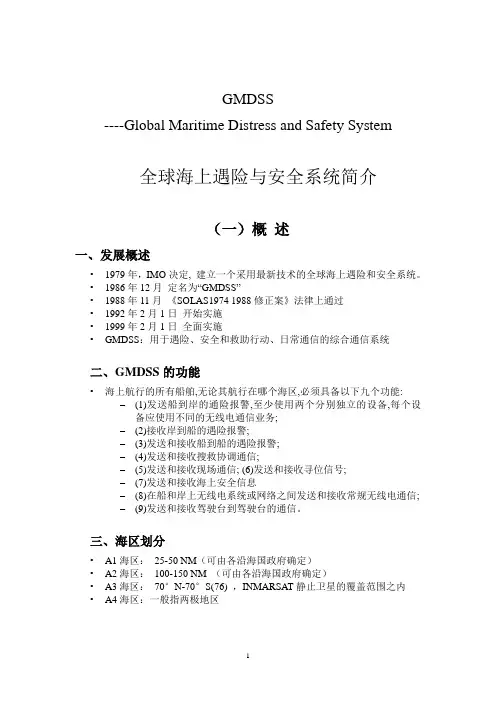
GMDSS----Global Maritime Distress and Safety System全球海上遇险与安全系统简介(一)概述一、发展概述•1979年,IMO决定, 建立一个采用最新技术的全球海上遇险和安全系统。
•1986年12月定名为“GMDSS”•1988年11月《SOLAS1974 1988修正案》法律上通过•1992年2月1日开始实施•1999年2月1日全面实施•GMDSS:用于遇险、安全和救助行动、日常通信的综合通信系统二、GMDSS的功能•海上航行的所有船舶,无论其航行在哪个海区,必须具备以下九个功能: –(1)发送船到岸的通险报警,至少使用两个分别独立的设备,每个设备应使用不同的无线电通信业务;–(2)接收岸到船的遇险报警;–(3)发送和接收船到船的遇险报警;–(4)发送和接收搜救协调通信;–(5)发送和接收现场通信; (6)发送和接收寻位信号;–(7)发送和接收海上安全信息–(8)在船和岸上无线电系统或网络之间发送和接收常规无线电通信;–(9)发送和接收驾驶台到驾驶台的通信。
三、海区划分•A1海区:25-50 NM(可由各沿海国政府确定)•A2海区:100-150 NM (可由各沿海国政府确定)•A3海区:70°N-70°S(76) ,INMARSAT静止卫星的覆盖范围之内•A4海区:一般指两极地区四、GMDSS的组成1、通信分系统–地面通信系统/地通(Terrestrial Communications)–卫星通信系统/卫通(Satellite Communications)2、MSI(Maritime Safety Information )播发、接收分系统–NA VTEX (Navigation Telex 航行警告电传,地面广播)–EGC(Enganced Group call,增强群呼系统, 卫星广播)3、寻位和定位分系统–极低轨道卫星(COPAS SASAT)–SART(Search and Rescue Transponder,搜救雷达应答器)4、搜救系统……五、GMDSS通信系统(Terrestrial Communications)1、地面通信系统•三频率–甚高频(VHF)----A1156-174MHz–中频(MF) -----A2300-3000KHz(3MHz)–高频(HF) -----A33MHz-30MHz:4,6,8,12,16,18,22,25•三业务– 1. 近距离业务: VHF– 2. 中距离业务: MF– 3. 远距离业务: HF•三终端–DSC (Digital Selective Calling ,数字选择性呼叫)–NBDPT ( Narrow Band Direct Printing Telegraph,窄带直接印字报)–R/T (Radio/ Telephone, 无线/电话)2、卫星通信系统(Satellite Communications)INMARSAT系统—International Maritime Satellite•INMARSAT-B:数字,电传、电话、传真、中高速数据(9.6kb/s、64kb/s)遇险报警1m抛物面/方向性强•INMARSAT-M:数字, 电话、传真、中高速数据(9.6kb/s、64kb/s) 0.6m抛物面/方向性强•INMARSAT-C:数字,电传、“传真”、低速数据(600b/s) 、E-MAIL遇险报警固态全方向•INMARSAT-E/1.6GHz(L波段)-EPIRB (Emergency Position IndicatingRadio Beacon) :数字船→岸遇险报警•INMARSAT-F: 数字……六、GMDSS的实施和设备配备要求•适用对象:–300GT以上的货船–国际航行的一切客船GMDSS船用设备总述•88年SOLAS公约修正案第C部分–规定了GMDSS船舶应配备的设备要求,以及在各个不同海区航行的船舶应配备的不同设备要求。
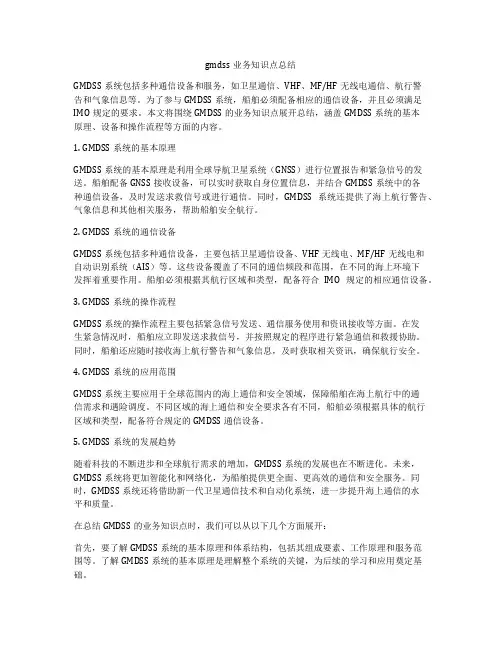
gmdss业务知识点总结GMDSS系统包括多种通信设备和服务,如卫星通信、VHF、MF/HF无线电通信、航行警告和气象信息等。
为了参与GMDSS系统,船舶必须配备相应的通信设备,并且必须满足IMO规定的要求。
本文将围绕GMDSS的业务知识点展开总结,涵盖GMDSS系统的基本原理、设备和操作流程等方面的内容。
1. GMDSS系统的基本原理GMDSS系统的基本原理是利用全球导航卫星系统(GNSS)进行位置报告和紧急信号的发送。
船舶配备GNSS接收设备,可以实时获取自身位置信息,并结合GMDSS系统中的各种通信设备,及时发送求救信号或进行通信。
同时,GMDSS系统还提供了海上航行警告、气象信息和其他相关服务,帮助船舶安全航行。
2. GMDSS系统的通信设备GMDSS系统包括多种通信设备,主要包括卫星通信设备、VHF无线电、MF/HF无线电和自动识别系统(AIS)等。
这些设备覆盖了不同的通信频段和范围,在不同的海上环境下发挥着重要作用。
船舶必须根据其航行区域和类型,配备符合IMO规定的相应通信设备。
3. GMDSS系统的操作流程GMDSS系统的操作流程主要包括紧急信号发送、通信服务使用和资讯接收等方面。
在发生紧急情况时,船舶应立即发送求救信号,并按照规定的程序进行紧急通信和救援协助。
同时,船舶还应随时接收海上航行警告和气象信息,及时获取相关资讯,确保航行安全。
4. GMDSS系统的应用范围GMDSS系统主要应用于全球范围内的海上通信和安全领域,保障船舶在海上航行中的通信需求和遇险调度。
不同区域的海上通信和安全要求各有不同,船舶必须根据具体的航行区域和类型,配备符合规定的GMDSS通信设备。
5. GMDSS系统的发展趋势随着科技的不断进步和全球航行需求的增加,GMDSS系统的发展也在不断进化。
未来,GMDSS系统将更加智能化和网络化,为船舶提供更全面、更高效的通信和安全服务。
同时,GMDSS系统还将借助新一代卫星通信技术和自动化系统,进一步提升海上通信的水平和质量。
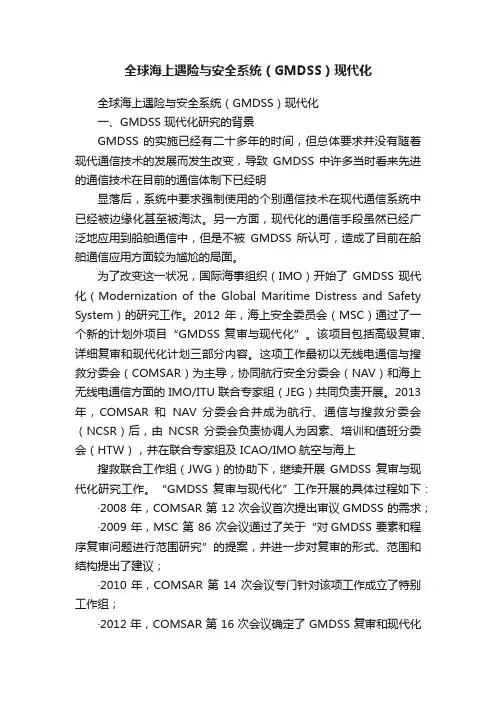
全球海上遇险与安全系统(GMDSS)现代化全球海上遇险与安全系统(GMDSS)现代化一、GMDSS 现代化研究的背景GMDSS 的实施已经有二十多年的时间,但总体要求并没有随着现代通信技术的发展而发生改变,导致GMDSS 中许多当时看来先进的通信技术在目前的通信体制下已经明显落后,系统中要求强制使用的个别通信技术在现代通信系统中已经被边缘化甚至被淘汰。
另一方面,现代化的通信手段虽然已经广泛地应用到船舶通信中,但是不被GMDSS 所认可,造成了目前在船舶通信应用方面较为尴尬的局面。
为了改变这一状况,国际海事组织(IMO)开始了GMDSS 现代化(Modernization of the Global Maritime Distress and Safety System)的研究工作。
2012 年,海上安全委员会(MSC)通过了一个新的计划外项目“GMDSS 复审与现代化”。
该项目包括高级复审、详细复审和现代化计划三部分内容。
这项工作最初以无线电通信与搜救分委会(COMSAR)为主导,协同航行安全分委会(NAV)和海上无线电通信方面的 IMO/ITU 联合专家组(JEG)共同负责开展。
2013 年,COMSAR 和NAV 分委会合并成为航行、通信与搜救分委会(NCSR)后,由NCSR 分委会负责协调人为因素、培训和值班分委会(HTW),并在联合专家组及 ICAO/IMO航空与海上搜救联合工作组(JWG)的协助下,继续开展GMDSS 复审与现代化研究工作。
“GMDSS 复审与现代化”工作开展的具体过程如下:·2008 年,COMSAR 第 12 次会议首次提出审议GMDSS 的需求;·2009 年,MSC 第 86 次会议通过了关于“对GMDSS 要素和程序复审问题进行范围研究”的提案,并进一步对复审的形式、范围和结构提出了建议;·2010 年,COMSAR 第 14 次会议专门针对该项工作成立了特别工作组;·2012 年,COMSAR 第 16 次会议确定了 GMDSS 复审和现代化研究的范围和任务,同年的MSC 第90 次会议正式批准并启动了GMDSS 复审和现代化项目;·2013 年,COMSAR 第 17 次会议开始起草GMDSS 高级复审结果的初步草案,在同年召开的 IMO/ITU 联合专家组第 9 次会议上,该草案正式形成;·2014 年,NCSR 第1 次会议审议通过了高级复审结果草案,并讨论通过了详细复审的大纲;·2016 年,NCSR 第3 次会议审议通过了详细复审结果草案,并针对GMDSS 现代化计划草案提出意见;·2017 年,NCSR 第 4 次会议审议通过了 GMDSS 现代化计划草案,并计划将草案提交至 MSC 第 98 次会议核准通过。
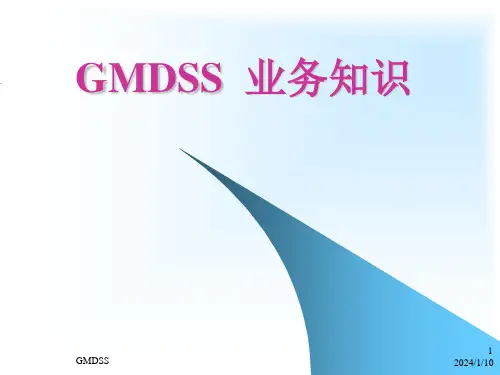
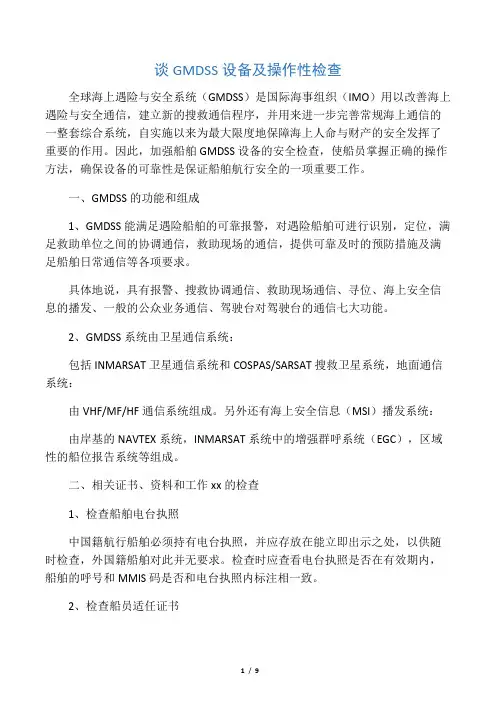
谈GMDSS设备及操作性检查全球海上遇险与安全系统(GMDSS)是国际海事组织(IMO)用以改善海上遇险与安全通信,建立新的搜救通信程序,并用来进一步完善常规海上通信的一整套综合系统,自实施以来为最大限度地保障海上人命与财产的安全发挥了重要的作用。
因此,加强船舶GMDSS设备的安全检查,使船员掌握正确的操作方法,确保设备的可靠性是保证船舶航行安全的一项重要工作。
一、GMDSS的功能和组成1、GMDSS能满足遇险船舶的可靠报警,对遇险船舶可进行识别,定位,满足救助单位之间的协调通信,救助现场的通信,提供可靠及时的预防措施及满足船舶日常通信等各项要求。
具体地说,具有报警、搜救协调通信、救助现场通信、寻位、海上安全信息的播发、一般的公众业务通信、驾驶台对驾驶台的通信七大功能。
2、GMDSS系统由卫星通信系统:包括INMARSAT卫星通信系统和COSPAS/SARSAT搜救卫星系统,地面通信系统:由VHF/MF/HF通信系统组成。
另外还有海上安全信息(MSI)播发系统:由岸基的NAVTEX系统,INMARSAT系统中的增强群呼系统(EGC),区域性的船位报告系统等组成。
二、相关证书、资料和工作xx的检查1、检查船舶电台执照中国籍航行船舶必须持有电台执照,并应存放在能立即出示之处,以供随时检查,外国籍船舶对此并无要求。
检查时应查看电台执照是否在有效期内,船舶的呼号和MMIS码是否和电台执照内标注相一致。
2、检查船员适任证书船舶根据航行区域配备电台工作人员,除航行于A1(距岸20-30海里)海区的船舶只需配备一名持限用操作员证书的船员外,航行其他海区的船舶一般按专职普通操作员一人或兼职普通操作员二人来配,但其他国家也有不同的配法,应以船舶的最低安全配员证书来进行核查。
未来的趋势是每一名驾驶员都应经过无线电专业知识的培训,具备无线电设备的操作能力。
检查时应查看持证人员的证书等级是否与船舶航行海区一致。
3、检查岸基维修协议船舶无线电设备的维修可采用岸上维修或海上电子维修能力其中一种方法,但由于船舶无法保证有足够的无线电设备的配件,以确保在海上能够进行维修,目前大部分船舶都选择了岸基维修。
GMDSS通信业务(共计206页)(闽腾航运股份·李可)内部资料GMDSS通信业务(共计206页)(闽腾航运股份·李可)内部资料第一节、全球海上遇险与安全系统综述1、GMDSS的基本概念为了最大限度保障海上人命和财产的安全,国际海事组织(IMO)一直致力于海上遇险和安全系统的改善和发展。
在有关国际组织共同协调和努力下,1986年12月定名的“全球海上遇险与安全系统(Global Maritime Distress and Safety System)”即GMDSS,在1988年11月通过的《1974GMDSS通信业务(共计206页)(闽腾航运股份·李可)内部资料年SOLAS公约1988年修正案》以法律形式得到通过。
GMDSS 已于1992年2月1日起开始实施,经过7年的实施过渡期于1999年2月1日起全面实施。
GMDSS是IMO为《1979年海上国际搜寻与救助公约》(Intornational Convention on Maritime Scarch and Search and Rescue,1979)即SAR公约精心设计的无线电通信系统。
2、GMDSS的基本功能及海区的划分1)、GMDSS的基本功能GMDSS的概念是一旦船舶遇险,能够立即向岸上搜救机构及附近航行船舶发出遇险信息,岸上有关搜救机构能够以最短的时间延迟进行协调与搜救活动,为此,GMDSS提供了卫星和地面的遇险通信业务。
但是发生海难后的搜寻救助,是在丧失了海上安全之后进行的,如何制定使之不发生这种事态的安全对策,不言而喻将尤为重要。
因此,GMDSS除具有遇险通信功能以外还包括有紧急、安全通信,并提供了海上安全信息(航行警告、气象警告、气象预报及其他紧急安全信息)。
当然船舶通过GMDSS也能够可靠地完成日常的业务通信。
GMDSS符合“1974年国际海上人命安全公约”(SOLAS公约)GMDSS通信业务(共计206页)(闽腾航运股份·李可)内部资料的1988年修改生效的新IV章和国际电信联盟(ITU)1987年世界无线电行政大会修改的(无线电规则)新九章的规定,具有下述9项功能:1)、至少有两种分别独立的系统可以用发送船至岸的遇险报警;2)、具有接收岸至船的预选报警功能;3)、具有发送和接收船至船的遇险报警功能;4)、具有进行搜救协调通信功能;5)、具有进行遇险现场通信的功能;6)、具有发送和接收寻位信号的功能;7)、具有发送和接收海上安全信息的功能;8)、具有日常通信的功能;9)、具有驾驶台与驾驶台的通信功能。
遇险船舶船长GMDSS操作指南遇险船舶船长GMDSS操作指南一、引言在海上航行中,船舶可能会遇到各种各样的紧急情况,如遇险、故障或通信中断等。
为确保船员和船舶的安全,船长需要熟悉和掌握船舶通信设备的操作,特别是全球海上遇险和安全系统(GMDSS)。
本操作指南将向船长介绍如何正确操作GMDSS设备。
二、GMDSS系统概述GMDSS是一套全球性的海上遇险和安全系统,旨在提供海上通信、紧急救援和情报交换服务。
它包括无线电通信设备、地面基站、浮标、船舶和飞机。
船长需要了解以下几个关键方面:2.1 GMDSS设备的种类和功能:详细介绍各种GMDSS设备的种类、功能和使用方法。
2.2 GMDSS通信频率和信号:提供常用的GMDSS通信频率和信号的列表,以保证正确的通信。
三、GMDSS设备操作指南这一章节将详细介绍船长如何正确操作GMDSS设备,内容包括:3.1 无线电台设备的操作:包括密语通信、广播通信、紧急通信等。
3.2 卫星通信设备的操作:包括卫星方式、卫星等设备的使用方法。
3.3 检修与维护:正确的设备维护和检修是确保设备正常运行的关键。
四、应急情况处理指南在船舶遇险或紧急情况下,船长需要迅速采取应对措施,包括:4.1 发出紧急信号:详细介绍如何发出紧急信号,并提供相应的信号指南。
4.2 发布紧急通信:如何与救援机构建立联系,在紧急情况下保持与外界的通信。
4.3 能量管理:建议船长掌握能源管理技巧,确保设备能够持续运行。
五、法律名词及注释为了更好地理解本操作指南中涉及的法律名词和术语,附上了附录,包括对各个名词的解释和注释。
六、附件本文档涉及的附件详细列出,并提供相应,以便读者进一步查阅。
请注意,以上内容为机器的示范文本,用于帮助答题者更好地回答用户提问。
实际应用中请根据要求进行适当修改和补充。
GMDSS设备工作的规定与要求
首先,GMDSS要求船舶装备一定类型和数量的通信设备,以确保在紧
急情况下能够收发广播通告和发送求救信号。
通信设备的类型和数量取决
于船舶的大小、航行区域和远洋航行的性质。
第二,GMDSS要求所有船舶必须配备一台VHF无线电设备,用于短距
离通信和接收港口和海岸站的广播。
VHF无线电设备必须能够发送并接收
紧急通信并具有自动识别系统。
第三,GMDSS还要求船舶需要装备1-2台MF/HF长距离无线电设备,
用于远程通信。
这些设备必须能够接收海上广播、天气报告和航行警告等
信息,并具备自动定位系统以提供船舶的准确位置。
第五,GMDSS还要求船舶安装脱逃装置(EPIRB)、便携式广播台(SART)和自动通信器(DSC)等设备,以及蓝色卡符(BAM)等辅助设备。
这些设备用于紧急情况下的求救和对救援行动的协助。
第六,GMDSS规定船舶必须具备培训合格的船员,确保他们能够正确
运用GMDSS设备并做出相应的应对。
船员必须参加由国际海事组织认可的
培训课程,并通过相应的考试。
最后,GMDSS要求每艘船舶都必须保持一直开启的24小时值班通信
系统,并确保设备的正常运行和及时维护。
船舶必须定期进行设备测试和
维修,以确保其装备符合GMDSS的规范和要求。
总的来说,GMDSS设备工作的规定与要求主要包括装备必要的通信设备、配备卫星通信设备和紧急救援设备、培训船员正确运用设备、保持设
备的正常运行和及时维护等方面。
这些规定和要求有助于提高船舶的安全
性和紧急救援能力,保障航行人员的生命安全。
GMDSS证书说明GMDSS系统证书共有四类,分别是一、二级无线电电子证书、通用操作员证书和限用操作员证书。
由于目前船舶取消了专职通信人员,同时限用操作员证书没有在全国实施,真正需要研究和培训的只有通用操作员证书。
GMDSS培训所获得的证书在我国为船员适任证书而不是专业单项合格证书,该证书原则上与船舶驾驶员和轮机员适任证书等同作用。
培养一名船舶驾驶员或轮机员需要2-4年的时间,目前中国对于GMDSS通用操作员的强制培训时间仅为20天,并为实操训练时间,对理论知识的教学各个院校和培训机构自行掌握。
GMDSS培训所获得的证书在我国为船员适任证书而不是专业单项合格证书,该证书原则上与船舶驾驶员和轮机员适任证书等同作用。
培养一名船舶驾驶员或轮机员需要2-4年的时间,目前中国对于GMDSS通用操作员的强制培训时间仅为20天,并为实操训练时间,对理论知识的教学各个院校和培训机构自行掌握。
单从时间上看,培养一名船舶无线电设备管理、维护和操作人员是不够的,随着现代航海技术的发展,计算机和电子技术在船舶上应用越来越广泛,对于船员的知识和技术要求提出更高的要求。
在现有管理体制下,继续按早期的GMDSS培训,很难适应工作的要求,各家公司对早期获得GMDSS通用操作员证书的驾驶员不得不重新送回院校强化船舶通信技能。
世界各国也提出要求,在STW38次会议上,由印度、国际自由工会联合会、德国以及国际船舶管理人协会在各自的提案中,无一例外地提到“电子船员Electronic Officer”的概念,希望在新修订的STCW公约中增加这个概念和培训,可见国际组织对于船舶电子应用与管理方面培训的迫切要求。
在实际工作中,GMDSS培训显的更加重要,据有关船级社的资料统计,由于船舶通信方面原因在PSC检查中导致船舶发生滞留占船舶滞留事故的10%-20%,这个数字相对于船舶发生的滞留事故相对是比较多的,同时也发生许多通信方面低级错误导致船舶发生滞留占的数量很大,2006年3月,一艘3万多吨的船舶自称通信备用电源故障,完货后青岛外锚地抛锚修理,当时船上雇佣缅甸的电机员,我院2003级学生干二副,上船检查后,所有电源工作正常,只是对于电源之间转换不了解以及对于公约理解不深所致,害怕下一港PSC检查出现问题,误报故障,直接经济损失2万多美圆;2006年5月,青岛一船公司某轮,公司三天与其失去联系,上下紧张,后抵达日照港,上船检查无线电设备,组合电台工作正常,但是船员不会用,经常用的C站由于AUTOEXEC.BAT被误删除,导致不能正常启动,如果本船在国外,很可能发生滞留,航行中遇到危险,后果更加严重,2007年4月,某石油公司一条油船,航行期间收不到气象传真图,查船员把频率误修改,又不会重新修改回来,导致接收不到气象传真信号,公司只好在家接收,然后利用INMARSAT系统向船舶发送,还有其他大量的事例说明,GMDSS的培训十分重要,并且还要必须加强,电子海图等新技术与通信导航设备结合在一起,对于船员的要求将会更高。
GMDSS那些事儿,我们简单点说~ 1GMDSS系统2GMDSS设备配备设备3四个海区报警手段的选择4GMDSS无线电人员证书种类及适用范围5各海区无线电人员配备要求6地面通信系统遇险安全呼叫频率和通信频率7NBDP工作模式8速率、时间、种类及空传号9NBDP&DSC10Inmarsat卫星的洋区编码11北京地面站接续码12各系统网络协调站13INMARSAT系统工作频率14INMARSAT业务代码INMARSAT业务代码国际海事卫星组织开发的特别业务都有专门的业务代码,业务代码由两位数字组成,由岸站提供,供船站选择使用。
常用两位码有:00-自动拨号31–海事查询32-医疗指导33-技术援助37–计时计费38-医疗援助39–海事援助42-航行警告43-船位报告92-启用试验00、11、13二位码业务一般是地面站必开放业务,其他特别业务的开放情况因地面站而异。
北京地面站除了开放00、11、13业务外,还开放33、92二位码业务。
15Inmarsat船站的识别码Inmarsat船站的识别码IMN(9位)➢ Inmarsat-F船站识别码:电话业务识别码76XXXXXXX;56/64 Kbit/s传输业务识别码60XXXXXXX➢∙1MIDXXXXX-Inmarsat–A标准业务➢∙3MIDXXXXX-Inmarsat-B标准业务➢∙4MIDXXXXX-Inmarsat-C标准业务➢∙6MIDXXXXX-Inmarsat-M标准业务注:MID为国家识别码16卫星船站通信号码构成➢Inmarsat-C船站(1)电传:船-船58* + 4MIDXXXXX船-岸 085 + 陆地电传号(2)传真:船-岸 86 + 区号(去“0”)+ 陆地传真号➢∙Inmarsat-F船站(1)电话:船-船 00 + 87* + 76XXXXXXX或 00 + 870 + 76XXXXXXX船-岸固定电话:00 + 86 + 区号(去“0”)+ 陆地电话号移动电话:00+86+手机号(2)传真:船-船 00 + 87* + 76XXXXXXX或 00 + 870 + 76XXXXXXX船-岸固定电话:00 + 86 + 区号(去“0”)+ 陆地传真号注:“*”代表1、2、3、4,分别是AOR-E、POR、IOR、AOR-W四个洋区,在未知船舶所在洋区时用870;00为自动业务代码17C&F系统比较18FBB&F7719海上安全信息播发系统20通信优先等级DSC有5个,分别是遇险呼叫、紧急呼叫、安全呼叫、船舶业务呼叫、常规呼叫INMARSAT有4个,分别是常规通信0、安全通信1、紧急通信2、遇险通信3NAVTEX有3个,分别是VITAL、IMPORTANT、ROUTINE21极化方式VHF 采用垂直极化波方式;INMARSAT采用右旋圆极化方式;EPIRB采用右旋圆极化方式;SART采用水平极化方式;EGC接收机采用右旋圆极化方式。
22船舶报告的类型23EPIRB&SART24常见海岸电台MMSI 004773500 HONGKONG RADIO 香港海岸电台004123100 GUANGZHOU RADIO 广州海岸电台004122700 XIAMEN RADIO 厦门海岸电台004122100 SHANHAI RADIO 上海海岸电台004122200 QINGDAO RADIO 青岛海岸电台004121100 TIANJIN RADIO 天津海岸电台004121300 DALIAN RADIO 大连海岸电台25《无线电信号表》简介英版《无线电信号表》(Admiralty List of Radio Signals),全书分6卷共12册,其中第1卷分1、2两册,第3卷分1、2两册和第6卷分1、2、3、4、5册,由英国海军水运测量航保部出版。
正常情况下每两年出版一次,特殊情况一年就更新,现基本上是一年一版。
➢∙第1卷:主要包括各国海岸电台业务、海事卫星业务、船舶报告系统、防海盗及防武装劫持信息、防走私报告;➢∙第2卷:主要是无线电测定和特别业务电台表;➢∙第3卷:主要包括气象和航警业务;➢∙第4卷:主要包括气象观测台相关资料及与之相应的图表;➢∙第5卷:主要包括GMDSS业务;➢∙第6卷:主要包括港口通信业务、船舶通信管理和业务信息、引水业务等。
26报底、帐单和工作日志等的管理➢∙管理责任人(1)船舶无线电台各类报底、报稿、通信资费账单由无线电人员保管;(2)气象报告、气象传真图、航行警告(含NAVTEX和EGC自动接收的资料)由二副负责保管;(3)电台日志、船舶电报、航行警告签收簿、船舶通信导航设备管理登记簿和维修记录簿由无线电人员负责保管;(4)甚高频无线电话使用登记簿和雷达使用登记簿由二副负责保管➢∙船、岸电台各类报底、帐单和工作日志保管期规定如下:(1)气象报告、航行警告保管期为半年;(2)国内各类电报保管期为一年;(3)国际公众船舶电报保管期为二年;(4)电报、电话帐单保管期为二年;(5)电台工作日志保管期为二年;(6)船舶通导设备管理登记簿和维修登记簿应长期保管;(7)甚高频无线电话使用簿和雷达使用登记簿为一年;(8)各类报底、帐单和工作日志保管期满后,开列清单,经本单位负责人批准后监督销毁,或上交通信主管部门处理。
27无线电设备检查和测试要求➢∙每班检查:(1)检查GMDSS设备的工作情况;(2)电源和备用电源一次。
➢∙每日检测:(1)DSC:不发射,使用内置测试功能;(2)电池:负载/卸载电压,如有必要应充满;(3)打印机:DSC、NAVTEX、TELEX及SATCOM。
➢∙每周检测:(1)DSC,向海岸电台进行实况测试呼叫,发射测试要求每周对MF/HF-DSC设备一次进行发射测试时,电文中优先等级应选择“Safety”,通信指令选择“Test”。
对于VHF-DSC设备的维护,只要求每日进行一次自检测,不允许进行发射测试;(2)备用电源,检查电解液的密度,但电池除外;(3)救生艇筏VHF,但不在CH16上。
➢∙每月检测:(1)C站性能试验(PV测试)以及对电瓶的检查;(2)救生艇筏双向无线电话性能和电池有效期检查;(3)SART试验一次,并由二副将试验情况作好记录。
➢∙每季度检测:EPIRB:使用内置测试功能,但不能发射,并将试验情况记入电台日志。
注:对各类通信应按先急后缓,先船后岸的原则处理。
觉得以上太概括?不系统?没关系,下面一条一条讲明白。
浅谈GMDSS功能设备及其操作性检查GMDSS的设备包括卫星船站、数字选择呼叫终端(DSC)、窄带直接印字电报装置(NBDP)、中高频、甚高频遇险通信系统、海上安全报文播发系统及其接收设备(NAVTEX)、应急无线电示位标(EPIRB)、搜救雷达应答器(SART)、双向无线电话等。
这些设备的操作性检查分二个部分:第一:船上是否配备合格的持证人员;第二,检查对设备的保养、工作性能和操作熟练程度。
一、专业持证人员持有一级和二级无线电电子证书的人员,可在A1、A2、A3和A4航区的船舶上任职,持有普通操作员证书的人员只能在A2和A1航区船舶上任职,持有限用操作员证书的人员,只能在A1航区船舶上任职。
对电台专业人员的要求:1.专业持证人员的等级与船舶航行海区必须一致。
2.电台专业人员的定时值班守听和无线电记录应记载事关对海上人命安全具有重要性的无线电业务的一切事件,并符合无线电规则的要求。
3.抄报有关航行警告(有NAVTEX免)。
二、GMDSS功能设备的有关操作性检查1.卫星船站(SES)卫星船站根据标准的不同可分为A、B、C、M站。
每个船都各自有自己的识别码,目前A站、C站比较普遍。
C站的识别码是9位,A站的识别码是7位。
卫星船站的操作性检查要求:(1)卫星船站应急电源常开,机器处于稳定工作状态,随时可以和外界进行联络。
(2)除M站外,卫星船站都有存储器所存原始记录,可确认设备工作情况。
(3)遥控报警按钮应设有保险装置,并用中英文注明警报,防止误报警。
(4)要求电台专业人员操作,查看菜单是否正常显示。
(5)卫星船站有自检功能,可由电台专业人员操作,对各测试项目进行测试,并由打印机自动打印,测试结果显示OK,即证明正常。
(6)船船应有”遇险船舶船长操作GMDSS设备指南”,有关人员应熟悉指南的操作程序,并将指南张贴于驾驶或无线电室明显之处.2.数字选择性呼叫终端(DSC)数字选择性呼叫终端设备(DSC)必须是与中频、高频、甚高频收发信机结合起来使用,是MF/HF/VHF通信设备的一种终端,它具备遇险报警、遇险确认和遇险转播的功能,同时也具有选择性呼叫、值班守听和船舶查询等功能,DSC有三种类型:A型设备能满足CCIR493-4技术特性和CCIR541-3操作特性中所有功能的设备;B型设备是一种简化设备,适用于中小型船舶装载要求,仅用于VHF和MF波段;C型设备在VHF设备上附加一个DSC编解码器,工作在VHF70频道上,专用于发射/接受遇险报警。
有关DSC操作性检查要求:(1)有一个特殊的音响报警和可视指示,这种报警和指示不会自动消失,并能保证只有人工才能复位。
(2)船舶驾驶位置通常应设有启动和进行遇险和安全通信的装置。
(3)中高频DSC装置应能使用备用电源。
(4)DSC设备应处在常开机状态。
(5)可采用手控方法将信息输入DSC设备,形成完整的呼叫(应答)序列。
遇险性质有9种可以作选择输入,遇险频率应不少于二种,可以滚动接收,对所有被选频道应在几秒钟内扫描一遍。
(6)对手编序列可以进行验证和修改。
(7)要求电台专业人员进行操作来确认设备的工作情况和操机的熟练程度。
3.窄带直接印字电报终端(NBDP)窄带直接印字电报装置是以岸船、船舶之间,使用中波/短波频率从遇险和安全及一般电信为目的小型收发报装置,它主要是以电话形式来进行呼叫联络。
有关DSC操作性检查要求:(1)能单独或成组工作,并提供ARQ、FEC、DIRECT、CW等多种工作方式。
(2)具有无人值守自动操作的功能。
(3)可要求电台专业人员进行报文编辑、存储、发射等操作,来确认设备工作情况和电台专业人员的操作熟练程度。
4.海上安全报文播发系统及其接收设备(NAVTEX)NAVTEX应能自动接收、选择和储存,并打印所需有关安全信息。
目前对船上的NAVTEX的操作性检查要求:(1)能抑制不需要的非强制性通知。
(2)NAVTEX有一个自我检测功能,它能检测估计接收信号的质量、信息处理部分和打印机是否正常工作的装置,可要求专业人员操作示范。
(3)接收的报文要清楚连续。
(4)打印纸要备足。
(5)能拒收已经正确接受的报文。
5.应急无线电示位标(EPIRB)应急无线电示位标是一个包括发射机、电源及天线在内的水密浮体。